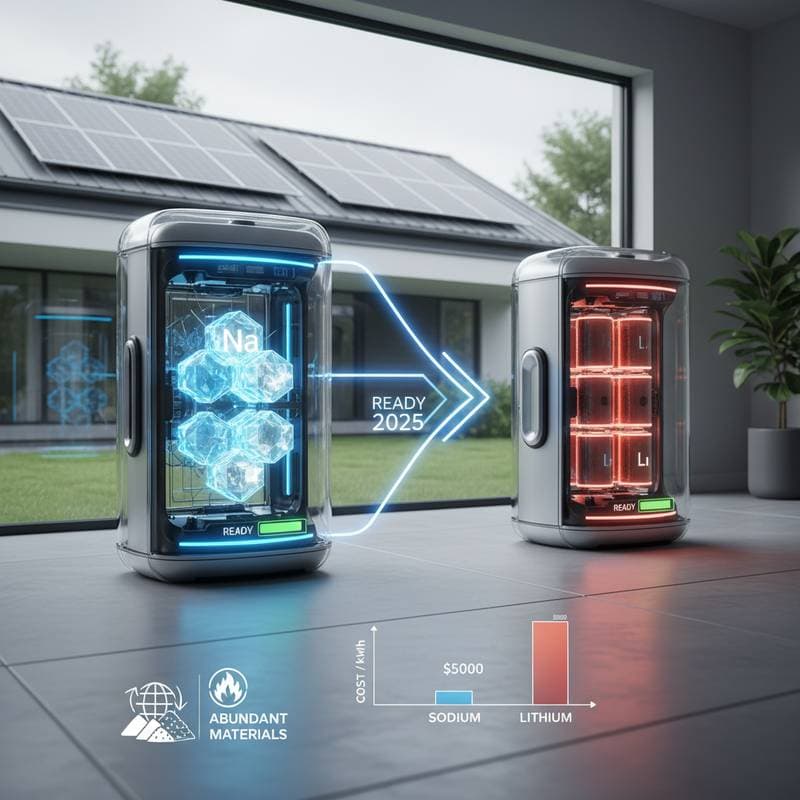Sodium-Ion Batteries: A Cost-Effective Alternative Set for 2025
Solar energy storage options continue to evolve rapidly. Homeowners often encounter lithium-ion batteries as the primary choice, but emerging technologies promise significant improvements. Sodium-ion batteries enter production in 2025, offering reduced costs and enhanced safety for solar systems and grid integration. Although lithium-ion maintains an edge in energy density, the widespread availability of sodium and its stable chemistry position this technology to transform energy storage practices.
Reasons for Growing Interest in Sodium-Ion Technology
Sodium-ion batteries gain traction due to the ubiquity of sodium. Extracted from ordinary salt, sodium avoids reliance on scarce minerals. This accessibility lowers sourcing expenses and mitigates risks from geopolitical tensions associated with lithium and cobalt extraction. Solar professionals, utility managers, and residential users alike value these attributes for dependable, economical energy reserves.
The core architecture of sodium-ion cells parallels that of lithium-ion batteries. Ions shuttle between cathode and anode via an electrolyte to facilitate energy storage and discharge. Sodium ions, being larger, result in modestly lower energy density. This means sodium batteries hold less power per unit weight compared to lithium versions. For fixed installations, such as home solar setups, where weight and volume play lesser roles, the advantages in affordability and security outweigh this limitation.
Understanding the Underlying Chemistry
During charging, sodium ions migrate from the cathode into the anode, typically composed of hard carbon. Upon discharge, the ions return to the cathode, driving electrons through an external circuit. This electron movement supplies power to household devices, lighting, or solar inverters. The mechanism resembles lithium-ion operation, but employs sodium-based materials like sodium iron phosphate or sodium manganese oxide.
Sodium chemistry operates at a lower voltage, yielding about 3 volts per cell versus 3.6 volts or more for lithium cells. Designers address this by linking additional cells in series to achieve equivalent voltage levels. Sodium compounds exhibit thermal stability, minimizing fire hazards. Home installations benefit from reduced need for elaborate cooling systems and heightened overall safety.
Comparing Costs and Performance in Practice
Lithium-ion home battery systems typically range from 800 to 1,000 dollars per kilowatt-hour, including installation. Projections place sodium-ion systems at 500 to 600 dollars per kilowatt-hour with expanded manufacturing. For a 10-kilowatt-hour solar storage unit, this equates to potential savings of 4,000 dollars or greater, factoring in installation variables.
Efficiency figures for sodium-ion batteries fall between 85 and 90 percent round-trip, approaching lithium-ion's 90 to 95 percent. Cycle life extends to 3,000 to 5,000 full charges before notable degradation, supporting 10 to 15 years of daily residential operation. Initial affordability and straightforward recycling may balance any minor durability differences.
Considerations for Residential Adoption
Lower energy density in sodium-ion batteries necessitates larger units, requiring ample space in areas like garages or utility rooms. Integration occurs via standard solar inverters, with leading brands preparing compatible updates. In grid-connected setups, sodium-ion storage aligns seamlessly with net metering or billing protocols, mirroring lithium-ion functionality.
Non-toxic sodium materials simplify recycling processes. Supply chains leverage established chemical production, bypassing intensive mining. This reliability curbs future price volatility and eases system expansions for solar users.
Analyzing Payback Periods and Investment Returns
Examine a home with a 7-kilowatt solar array producing approximately 1,300 kilowatt-hours per kilowatt annually, totaling 9,100 kilowatt-hours yearly. At a utility rate of 20 cents per kilowatt-hour, annual savings reach 1,820 dollars. A 10-kilowatt-hour battery captures surplus energy for peak hours, further cutting bills and enhancing self-sufficiency.
Priced at 500 dollars per kilowatt-hour, the sodium-ion setup totals 5,000 dollars prior to rebates. If it offsets an additional 400 dollars in annual utility expenses, payback occurs in about 12 years. Federal tax credits covering up to 30 percent, alongside state incentives, accelerate this timeline. Such calculations affirm sodium-ion viability, particularly with safety and sustainability benefits.
Anticipating Initial Market Rollouts
Initial sodium-ion applications target community microgrids and modest commercial installations before residential expansion. Producers ramp up pilot facilities for swift scaling upon confirmed demand. Solar contractors collaborating with these firms provide cost-effective options with minimal reconfiguration.
Philadelphia-area residents stand to gain from sodium-ion advancements in solar storage. Abundant local sunshine, temperate climate, and reasonable electricity tariffs create an ideal environment for innovative solutions.
Maintenance Guidelines for Longevity
Sodium-ion batteries demand little routine care. Position units in dry, well-ventilated spaces maintaining temperatures from 50 to 90 degrees Fahrenheit. Monitor charge levels and system performance through inverter applications. Warranties often span 10 years or specified cycles. Prevent discharges below manufacturer thresholds to maximize durability. Arrange annual professional reviews to verify connections and update software.
Frequently Asked Questions
Are sodium-ion batteries suitable for residential applications?
Yes, their stable chemistry resists overheating more effectively than lithium-ion alternatives.
What space requirements apply to a sodium-ion battery installation?
A 10-kilowatt-hour unit occupies space comparable to a compact refrigerator, with provisions for adequate airflow.
Do current solar inverters support sodium-ion batteries?
Hybrid inverters frequently accommodate them via firmware enhancements; verify with the producer.
What primary benefits distinguish sodium-ion from lithium-ion?
Reduced material expenses and superior safety from non-combustible properties.
